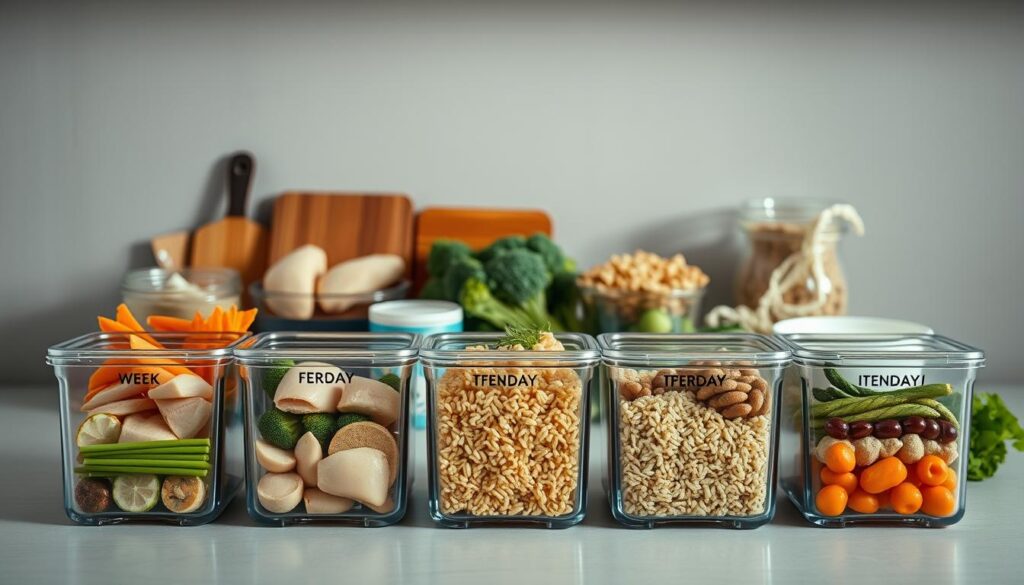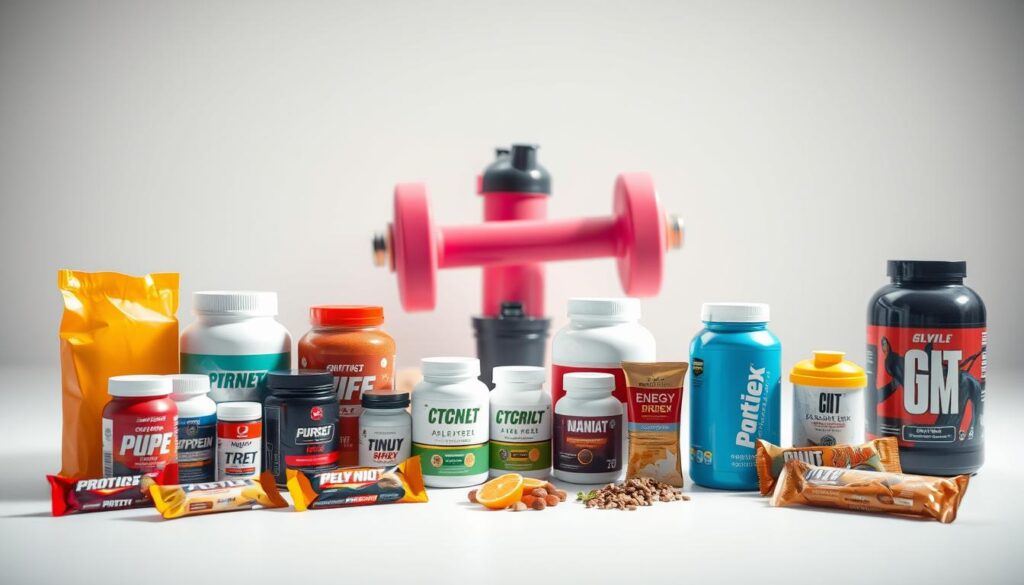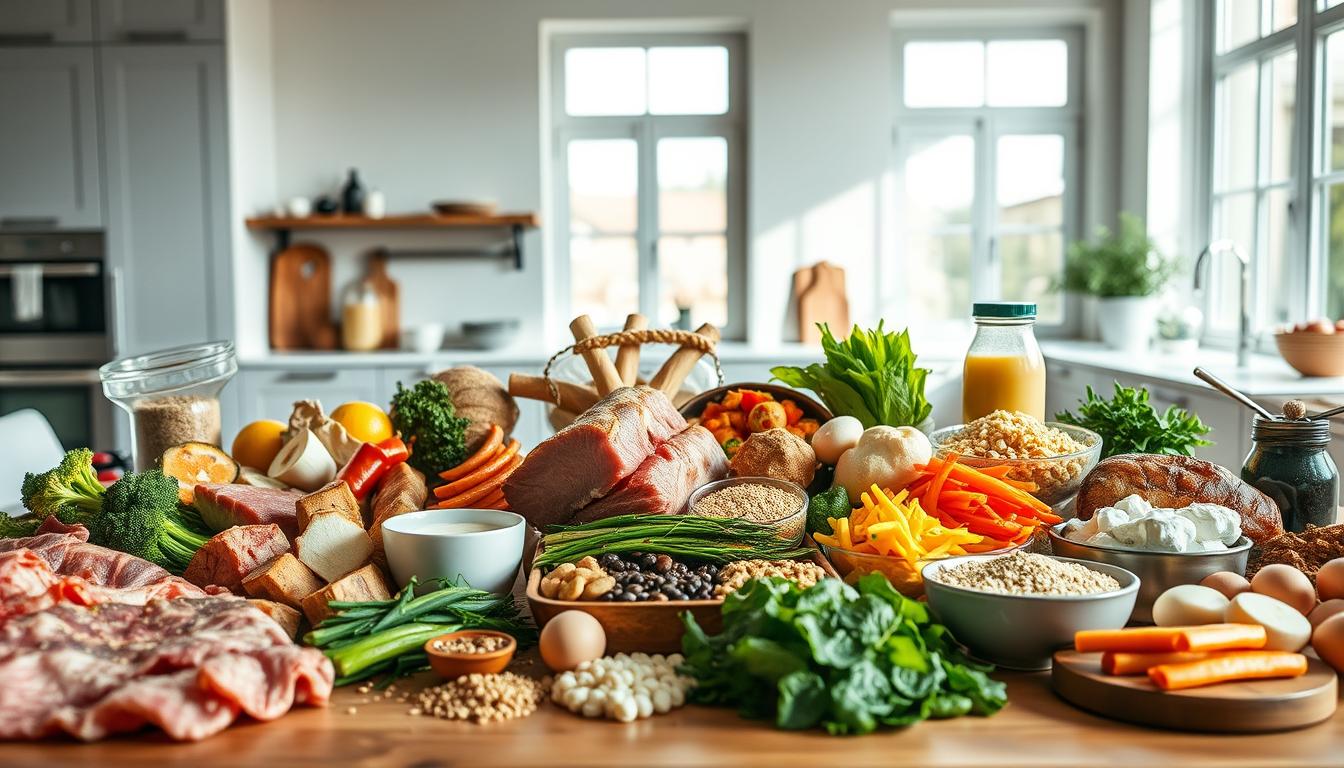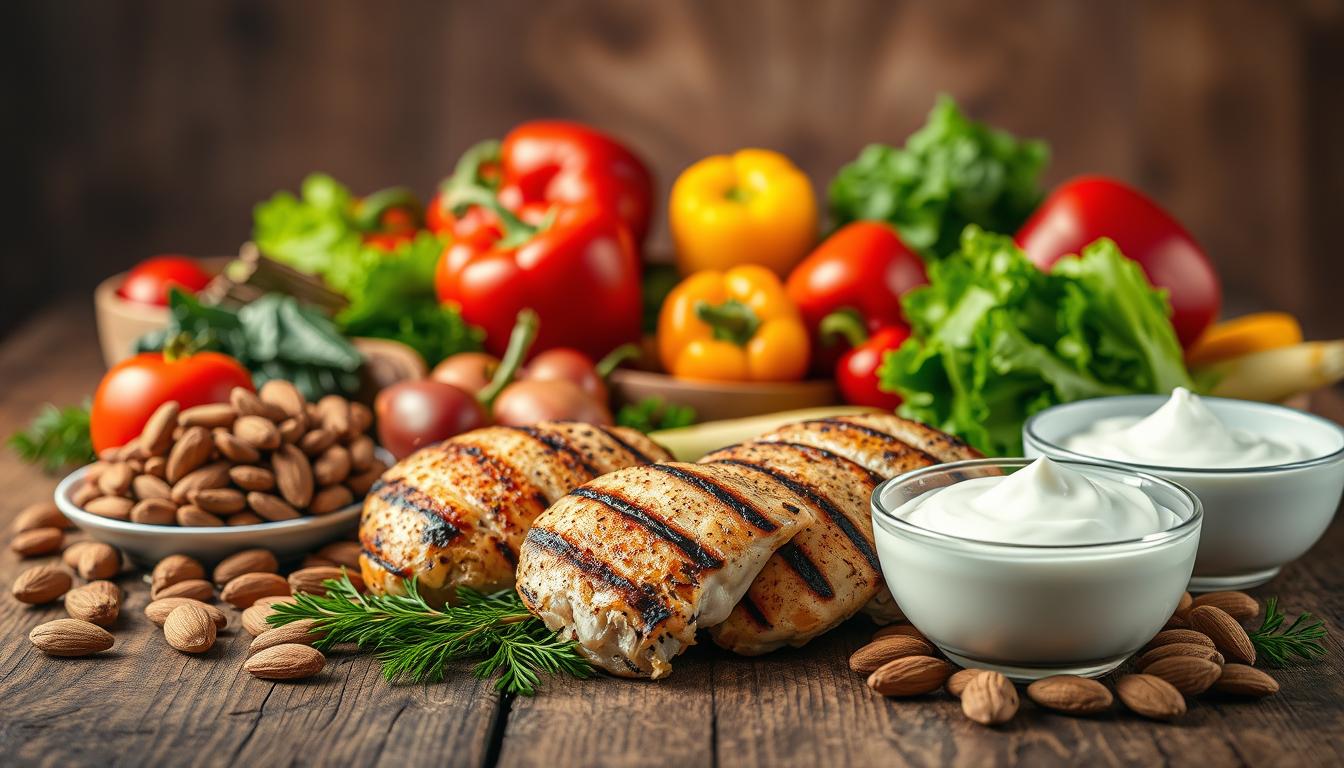When I first started my fitness journey, I quickly realized that nutrition is just as important as lifting weights. Building muscle isn’t just about the hours you spend in the gym—it’s about what you put on your plate every day. I’ve learned that tracking calories and macronutrients is essential to achieving my goals.
Each meal plays a crucial role in fueling my body. Whether it’s a post-workout shake or a hearty dinner, I focus on getting enough protein to support muscle repair and growth. Over time, I’ve seen how a well-structured approach to eating can make all the difference.
This guide is based on both scientific research and my personal experience. I’ll share insights on how to balance your intake to maximize results. Let’s dive into the details and create a strategy that works for you.
Key Takeaways
- Nutrition is a key factor in building muscle alongside exercise.
- Tracking calories and macronutrients is essential for success.
- Protein plays a vital role in muscle repair and growth.
- Each meal should contribute to your daily nutritional goals.
- Balance and consistency are crucial for long-term results.
Setting the Foundation for Muscle Growth
Building a strong foundation starts with understanding the basics of caloric balance. Whether you’re aiming to bulk up or lean out, knowing how your body uses energy is key. A calorie surplus helps you gain weight, while a calorie deficit supports fat loss. Both strategies play a role in achieving your fitness goals.
🏃 Start Your Weight Loss Journey Now!

To determine your maintenance calories, consider factors like age, weight, and activity level. For example, a moderately active person might need around 2,500 calories daily. Adding 300-500 calories creates a surplus for muscle growth, while reducing intake by the same amount promotes fat loss.
Understanding Calorie Surpluses and Deficits
A calorie surplus is essential for building muscle. It provides the extra energy your body needs to repair and grow. On the other hand, a calorie deficit helps shed fat by forcing your body to use stored energy. Balancing these phases is crucial for long-term success.
For instance, if your maintenance calories are 2,500, consuming 2,800 daily supports muscle gain. Conversely, eating 2,200 calories helps with fat loss. Tracking your intake ensures you stay on track.
Calculating Your Macronutrient Needs
Macronutrients—protein, carbs, and fat—are the building blocks of nutrition. A common ratio for muscle growth is 30-35% protein, 55-60% carbs, and 15-20% fat. This balance fuels your workouts and aids recovery.
For example, a 180-pound person might aim for 180 grams of protein daily. Lean sources like chicken and plant-based options like beans are excellent choices. Pair them with complex carbs and healthy fats for a well-rounded diet.
Setting realistic goals and tracking your progress ensures you stay motivated. Remember, consistency is the key to achieving lasting results.
My Personal Journey with Bodybuilding Diets
Early on, I relied on straightforward meals to fuel my workouts. My diet was simple, focusing on high-protein foods like eggs and easy snacks such as a slice of whole-grain bread or an apple. These basics helped me build a foundation for more advanced strategies later.
🚀 Boost Your Metabolism & Lose Weight!

Early Experiences and Newbie Gains
When I first started lifting, my meals were uncomplicated. I’d often have scrambled eggs for breakfast, paired with a slice of toast. For snacks, I’d grab an apple or a handful of nuts. These simple choices provided the energy I needed to push through workouts.
I noticed quick progress during this phase, often referred to as “newbie gains.” My body responded well to consistent training and basic nutrition. It was a reminder that even small changes can lead to significant results.
Lessons Learned from Diet Experiments
As I progressed, I began experimenting with different approaches. I tried high-protein diets, carb cycling, and even plant-based eating. Each experiment taught me something valuable about how my body responds to food.
For example, I learned that timing matters. Eating a sliceof whole-grain bread with peanut butter before a workout gave me sustained energy. Post-workout, I’d have a protein-rich meal with eggs and vegetables to aid recovery.
Over time, my approach evolved from basic snacks to a more structured meal plan. This shift helped me achieve consistent progress and avoid plateaus.
| Food | Role in My Diet |
|---|---|
| Eggs | Primary protein source for muscle repair |
| Slice of Whole-Grain Bread | Quick energy source before workouts |
| Apple | Healthy snack for sustained energy |
Looking back, I’m grateful for the lessons I learned along the way. Starting with simple foods allowed me to build a strong foundation. As I refined my meal plan, I saw even greater results. Consistency and adaptability have been key to my success.
Meal plan for muscle mass gain: Strategies and Guidelines
Crafting a strategy for muscle development requires precision and discipline. A well-structured approach ensures you meet your goals efficiently. Tracking calories and macronutrients is the foundation of this process. It helps you understand how much energy your body needs and where it comes from.
Calorie Counting and Macronutrient Ratios
To build muscle, you need a caloric surplus. This means consuming more calories than you burn. For example, a 175-pound person might aim for 2,800 calories daily. Protein should make up about 30% of your intake, carbs 55%, and fats 15%.
Tracking these ratios ensures your body gets the nutrients it needs. Tools like apps or food journals can simplify this process. Consistency is key to seeing results.
Foods to Embrace and Foods to Limit
Focus on nutrient-dense foods that support your goals. Potatoes and rice are excellent sources of carbs. They provide sustained energy for workouts and recovery. Pair them with lean proteins like chicken or plant-based options for a balanced diet.
On the other hand, limit foods high in butter or unhealthy fats. These can hinder progress and lead to unwanted fat gain. Moderation is essential for long-term success.
Each person can adapt these strategies to their unique needs. A disciplined approach ensures you stay on track and achieve your goals.
7-Day Muscle Gain Meal Plan Breakdown
Structuring your week around a balanced diet is essential for achieving your fitness goals. A well-organized approach ensures you get the nutrients needed to support intense training and recovery. Here’s a detailed breakdown of a 7-day plan to help you stay on track.
Daily Meal Samples and Timing
Timing your meals correctly can maximize energy and recovery. Start your day with a protein-rich breakfast, like scrambled eggs with a slice of whole-grain bread. Mid-morning, snack on an apple and a handful of walnuts for sustained energy.
Lunch could include grilled chicken with roasted veggies and a drizzle of olive oil. Post-workout, focus on recovery with a protein shake and a small portion of cheese. Dinner might feature turkey ratatouille with brown rice, and end the day with a light snack like Greek yogurt.
Portion Control and Nutritional Balance
Portion control is key to managing weight and ensuring you’re not overeating. For example, measure out a tablespoon of oil when cooking to avoid excess calories. Include healthy fats like walnuts in moderation to support overall health.
Balancing macronutrients is crucial. Aim for 30% protein, 55% carbs, and 15% fats daily. This ratio fuels your training and aids muscle repair. Use the table below as a guide for daily meals.

| Meal | Example | Portion |
|---|---|---|
| Breakfast | Scrambled eggs with whole-grain bread | 2 eggs, 1 slice |
| Snack | Apple and walnuts | 1 apple, 1 oz |
| Lunch | Grilled chicken with roasted veggies | 6 oz chicken, 1 cup veggies |
| Post-Workout | Protein shake with cheese | 1 scoop protein, 1 oz cheese |
| Dinner | Turkey ratatouille with brown rice | 6 oz turkey, 1/2 cup rice |
| Snack | Greek yogurt | 1 cup |
Following this weekly structure helps maintain consistency and ensures you’re meeting your nutritional needs. Adjust portions based on your weight and training intensity for optimal results.
Supplement and Pre/Post-Workout Nutrition Tips
To maximize your training results, understanding the role of supplements and meal timing is crucial. Proper nutrition before and after workouts can significantly impact your performance and recovery. Here’s how to optimize your approach.
⏳ Exclusive Offer Just for You!

Recommended Supplements for Muscle Growth
Certain supplements can enhance your results. Whey protein is a staple for muscle repair, providing 20-40 grams of protein per serving. Creatine boosts strength and endurance, while caffeine can improve focus during workouts.
I’ve found that combining these supplements with a balanced diet yields the best results. For example, I take whey protein post-workout to support recovery and creatine before training for added energy.
Optimizing Pre- and Post-Workout Meals
Timing your meals correctly is essential. Before a workout, I recommend a shake with 20 grams of whey protein and 20-40 grams of carbs. This provides energy without feeling heavy.
After training, focus on recovery. A meal like steak with sweet potato is ideal. It delivers protein for muscle repair and carbs to replenish glycogen stores. Measuring nutrients in grams ensures precision and consistency.
| Supplement | Role | Recommended Dosage |
|---|---|---|
| Whey Protein | Muscle repair and growth | 20-40 grams post-workout |
| Creatine | Strength and endurance | 5 grams pre-workout |
| Caffeine | Focus and energy | 200-400 mg pre-workout |
By integrating these strategies, you can enhance your health and achieve greater strength. Consistency in supplement use and meal timing is key to long-term success.
Practical Meal Prep and Planning Advice
Efficient meal preparation has been a game-changer in my fitness routine. By organizing my meals in advance, I’ve saved time and ensured consistency in my nutrition. Batch cooking and smart grocery shopping are two strategies that have made a significant difference.
Batch Cooking and Grocery Shopping Tips
Batch cooking is a lifesaver when it comes to staying on track. I often prepare large quantities of lean chicken breast and brown rice at the start of the week. This ensures I have healthy options ready to go, even on busy days.
When grocery shopping, I focus on quality ingredients. I stock up on staples like chicken breast, brown rice, and fresh vegetables. Buying in bulk not only saves money but also ensures I always have what I need.
Measuring Portions and Tracking Nutrients
Accurate portion control is key to meeting my goals. I use a cup measurement system to track my intake. For example, I measure out a cup of cooked brown rice or a cup of vegetables for each meal.
Tracking carbohydrates and overall macronutrient requirements helps me stay balanced. I aim for 30% protein, 55% carbs, and 15% fats daily. This ratio fuels my workouts and supports recovery.
Preparing Protein Shakes in Bulk
I also prepare protein shakes in bulk to save time. I mix a large batch of whey protein with water or almond milk and store it in the fridge. This way, I have a quick and convenient option post-workout.
By integrating these strategies, I’ve streamlined my nutrition and stayed consistent with my goals. Planning ahead and tracking my intake ensures I’m always on track.
Scientific Insights and Expert Nutrition Advice
Understanding the science behind nutrition has transformed my approach to fitness. By diving into research and expert guidelines, I’ve learned how to optimize my diet for long-term success. The International Society of Sports Nutrition provides valuable standards that have shaped my daily habits.
Standards from The International Society of Sports Nutrition
According to the International Society of Sports Nutrition, active individuals need about 1.6 to 2.2 grams of protein per kilogram of body weight per day. This ensures muscle repair and growth. Timing is also crucial—eating every 3 to 4 hours maintains a steady flow of nutrients.
For example, I aim for 30 grams of protein per meal, spread across 4 to 5 meals daily. This approach aligns with scientific recommendations and supports my training demands. Consistency in meeting these needs is key to achieving results.
Expert Recommendations for Sustainable Meal Planning
Experts emphasize the importance of including nutrient-dense foods like almonds and fiber-rich vegetables in your diet. Almonds provide healthy fats, while vegetables offer essential vitamins and minerals. These foods meet the everyday nutritional need and support overall health.
I’ve found that incorporating a handful of almonds as a snack boosts my energy levels. Pairing them with vegetables like spinach or broccoli ensures I’m getting enough fiber. This combination aids digestion and keeps me feeling full longer.
Here’s a breakdown of daily nutrient goals based on expert advice:
| Nutrient | Daily Requirement |
|---|---|
| Protein | 1.6-2.2 g/kg body weight |
| Carbohydrates | 5-7 g/kg body weight |
| Fats | 20-35% of total calories |
| Fiber | 25-30 g |
By following these guidelines, I’ve created a sustainable approach to nutrition. Proper meal timing and balanced intake ensure I’m fueling my body effectively.
Conclusion
Over the years, I’ve discovered that combining the right foods with consistent effort leads to incredible results. Nutrient-dense choices like peanut butter and lean proteins such as chicken breast have been staples in my routine. They provide the energy and building blocks needed for progress.
Pairing these foods with a structured workout routine has been essential. Consistency in both diet and exercise ensures steady growth and recovery. Adding the right supplement can also enhance your results, but they should complement, not replace, a balanced approach.
I encourage you to experiment with these strategies and adapt them to your unique needs. Remember, small, consistent steps lead to lasting success. Start today and see how these changes can transform your journey.
FAQ
How do I calculate my calorie needs for muscle growth?
What’s the ideal macronutrient ratio for building muscle?
Which foods should I include in my diet for muscle gain?
How often should I eat to maximize muscle growth?
Are supplements necessary for muscle gain?
What’s the best pre-workout meal?
How can I meal prep effectively for muscle gain?
How do I balance strength training with my diet?
Can I still gain muscle while limiting fat gain?
What’s the role of hydration in muscle growth?
Did you like this article? See also: Best Supplements to Boost Your Energy








Comment on “My Meal Plan for Muscle Mass Gain: Complete Guide”